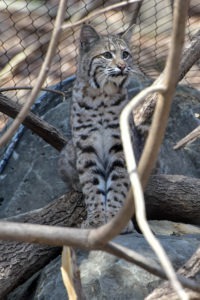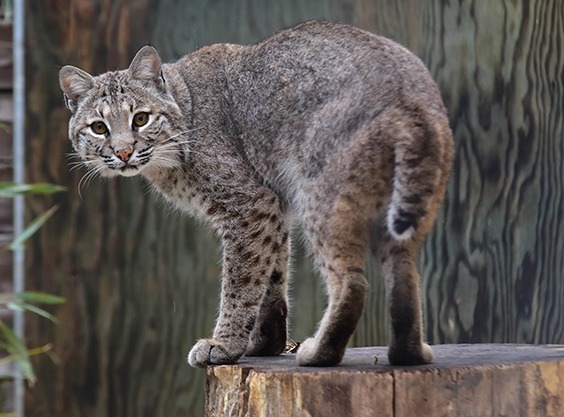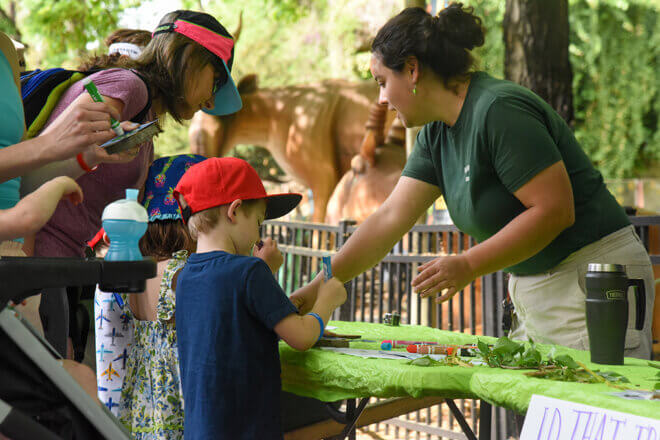The Maryland Zoo in Baltimore is pleased to announce the opening of the Bobcat Exhibit in the Maryland Wilderness area. “We are thrilled to say that the renovations are complete and we now have a wonderful new home for bobcats at the Zoo,” said Don Hutchinson, president/CEO of The Maryland Zoo. “Bobcats, while native to Maryland, are seldom seen in the wild, and we think our visitors will be excited to see and learn about these fascinating animals.”

The bobcat exhibit is adjacent to the otters just outside of the Marsh Aviary and formerly housed red fox. The overall habitat space measures 770 square feet, which includes both the pool and land areas. “We demolished some of the high rock walls that previously surrounded the exhibit and created a lot of vertical space to give the bobcats room to climb and jump,” continued Hutchinson. “We worked to give these animals a space that replicates their native habitat, as well as to provide our guests the ability to see them.”
The bobcat exhibit was designed by CLR Design, a zoo architecture firm located in Philadelphia, PA, and was built by Baltimore-based Kimball Construction Company. The mesh top, which will create the vertical space above the ground level of the exhibit, was crafted by Nets Unlimited, with interior caging by Corners Unlimited and rockwork by Cemrock. Funding for the work was provided by the State of Maryland and the exhibit is sponsored by Frostburg State University, home of the Frostburg Bobcats. Zoo President Don Hutchinson is a proud alumnus of Frostburg State University.
“The Frostburg State University Bobcats, both current and alumni, are pleased that the Maryland Zoo bobcats will have such a well-designed new habitat,” said Frostburg President Ronald Nowaczyk. “Since Frostburg State and bobcats share the western Maryland region, it is fitting and our privilege to partner with The Maryland Zoo to showcase a species native to our part of this great State.”
Bobcats (Lynx rufus) are nocturnal, thus they are seldom seen by humans, despite roaming throughout much of North America and living in such diverse habitats as forests, swamps, deserts, and even suburban areas. Bobcats are mainly found in western Maryland, they can also be seen occasionally in the Piedmont region and very rarely along the Atlantic Coastal Plain. “Bobcats are actually the most abundant wild cat in the U.S.,” noted Erin Cantwell, mammal collection and conservation manager at the Zoo. “They grow up to around 30 lbs, about twice the size as a housecat, and thrive on a varied diet of birds, mice, squirrels, rabbits and other smaller animals. They are named for their distinctive short, “bobbed” tail.”

The Maryland Zoo has two bobcats — a young male bobcat named ‘Kilgore’ and six-year-old female named Josie. Kilgore was found by an Oregon fisherman in June 2016, and the Oregon Department of Fish & Wildlife took possession of the kit before turning him over to the Oregon Zoo. “Oregon Zoo staff took him in when he was approximately 6-weeks-old and weighed a little less than 2 pounds,” continued Cantwell. “He was in good health, however since he had been found alone at such a young age, he was not a candidate for release back to the wild.” Staff at the Oregon Zoo raised him for a few months before he was transferred here in September. Kilgore will be in the bobcat exhibit from 10:00 am until 1:00 pm for the time being as he acclimates to the new space.
Josie came from the Tulsa Zoo where she had been placed after being confiscated from a private owner. Josie and Kilgore will be companion animals and are not recommend for breeding. Josie has not been fully acclimated to the exhibit and will not be on public view just yet.
“The two bobcats have very different personalities, but are both gorgeous representatives of their species,” concluded Hutchinson. “We hope people enjoy getting to know them and learning about these special native cats.”






Share this article